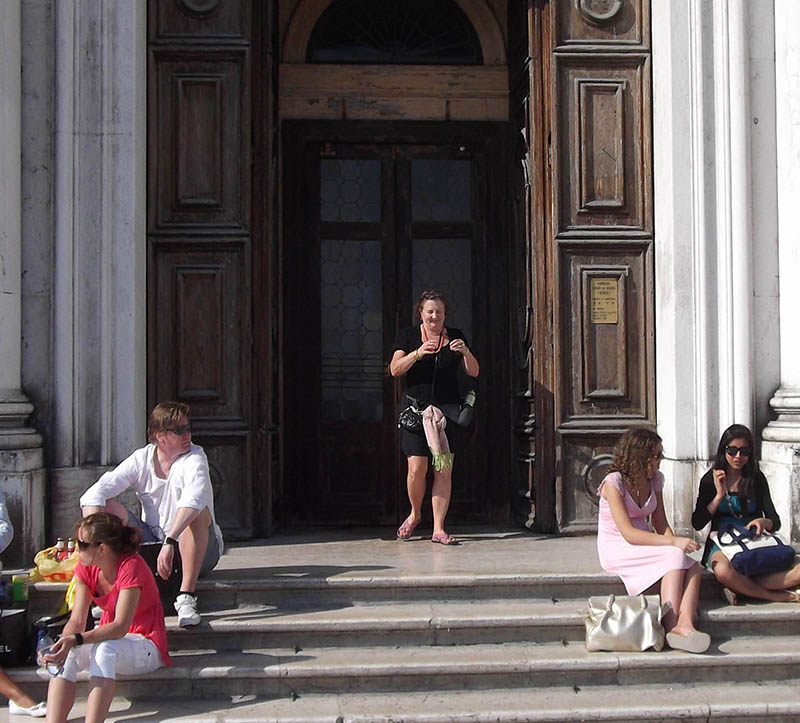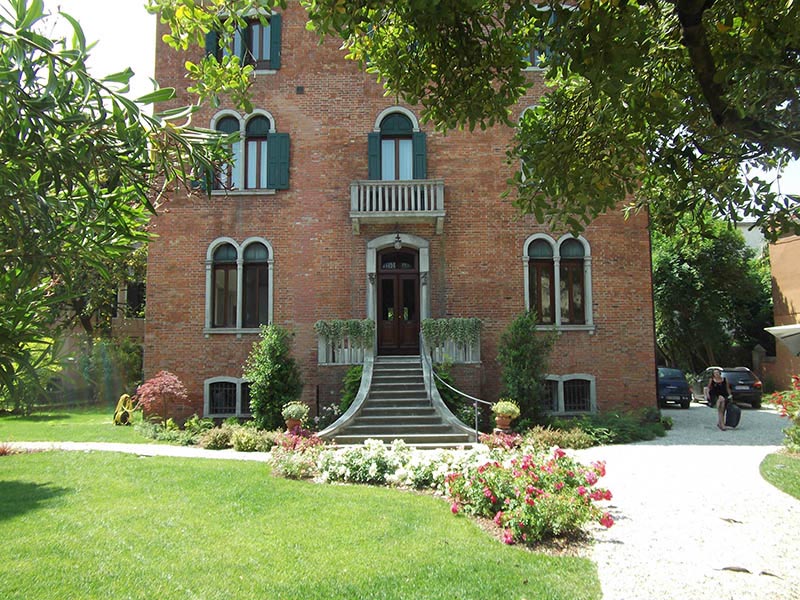Oh,
and the Lido, and Chioggia. And Torcello.
We
wanted to go to Venice again. Paintings, history, decaying architecture,
etc. But we can't afford it anymore. So we went to the Lido.
Torcello, for a change, and Venice, and then home

We're leaning off the back of the round-the-whole-lagoon boat from the Lido for a photo and coming into Burano now. En route to Torcello.

Burano island, very colorful

That's Torcello -- we're waiting for the little shuttle ferry across the water. Not much to look at now, is it?

This is where in the mid-5th century the refugees in the region first fled the barbarian raids on terra firma and set up out in the more defensible islands. Attila the Hun was only the most famous of many Germans, Lombards, Franks, and what not other rampaging, nomadic Blackwater-types who pillaged through the area and confirmed the Torcellians in their decision.

We're walking the kilometre or so from the boat dock into what remains of ancient Torcello, which is very little. In 638 the bishop moved his see here, too, and stayed for the next millenium. Supported by its salt-harvesting industry, Torcello was a fairly autonomous outpost of the Byzantine empire, with profitable trade ties to Constantinople. By the mid-900s, Torcello had about 10,000 citizens and was more prosperous and powerful than Venice, the upstart across the lagoon.

In its heyday, this was a bustling urban centre of 12 parishes, with palaces, religious, public, and residential buildings all over the place, but then, in the 12th century, the whole island began to decline into a malarial swamp, and everybody had to revise their career plans (like everyone in the world's coastal cities 50 years from now).

Only four of the original buildings remain, two 14th century civic palaces that house the local museum (left), the Cathedral of Santa Maria Assunta, founded in 639 and boasting excellent Byzantine-style mosaics, and the 11th-century Church of Santa Fosca (on the right). As the population moved on to Rialto Venice, they came back frequently to rip off all the building materials for the expanding Venice downtown.

"Attila's Throne", this is called, though it's not really -- it is old, though. Somebody's throne, anyway. Maybe a bishop, it's said.

But the spirit of Attila hovers over it still.

Into the basilica church of Santa Maria Assunta, to see the great stuff

The Last Judgment -- ooof! grim! -- 12th century mosaics from the Byzantine-Ravenna tradition, too bad we can't get up closer, or use a flash. (Even without the flash, the PhotoNazi shouted out "Nah Footahs" and rose from her chair in the far corner.)

Strolling around what's left of the 7th-century baptistry, which was renovated into desuetude in the 9th century.

My fourth-grade teacher, Mrs Klotz

Ex-baptistry, and the Greekish 11th-12th century church of Santa Fosca on the far side. (Santa Fosca?!?! [Saint Fusca of Ravenna, a teenage Christian who was stabbed to death by non-Christian family members during the Decian persecutions, ca. 250])

We're progressing from one part of the museum to the next

Ancient sages. Museum pieces.
Returning to the boat, we walked right by the Ponte del Diavolo over the canal, built in 1202, and I didn't take a picture of it because I was thinking about lunch.

Now we're in Burano and having a look around.

Window-shopping again. This time for lace -- Murano does blown glass; Burano does lace. I don't know what you do with lace. Doilies? Antimacassers?

Burano, like Venice, has canals, too.

-- Tourist alert, mama!

Kristin passing a kayak farm

Kristin photographing people when asked (no charge but the tips add up)

This must be one of the world's most effective Condo Committees. Who chooses the colors? Homeowners? The mayor?
[Wikipedia anticipated us: "The colours of the houses follow a specific system originating from the golden age of its development; if someone wishes to paint their home, one must send a request to the government, who will respond by making notice of the certain colours permitted for that lot. This practice has resulted in the myriad of warm, pastelly colours that characterises the island today."]

Sea-level rise is coming here, too, and we're ready.

Kristin strolling through colorful Lego Town

I had the most horrible touristic recollections of Burano, but guess what? I was remembering Murano. Burano is very nice.

Another leaning tower (the campanile of the San Martino church)

And another beautiful canal that somebody needs to fill up before Global Warming hits

The main thoroughfare, and a little girl on a bicycle who managed somehow to get into half the photos I took here, with her brother. Or Significant Other.

Oh, right, fill them in, before Global Warming catches up with us.

Surrealist street scene

We're lost again

She's back, the little minx.

Burano street scene

The VIPs' table

A couple of decent panini later, and a boat trip past Murano and the San Michele cemetery island, and a walk in through Cannaregio from the Fondamenta Nuove, we've fetched up at the rail station again. Okay, we're booked!

The Zattere region: we're using up our last afternoon here devoid of purpose or inspiration.

A tower that is not leaning

A gondola repair shop (Rio di San Trovaso)

A very heavy crown for a little kid.
We're in the Santa Maria del Rosario (called the "Gesuati"), a mid-18th century Dominican extravaganza that despite the name's not really affiliated with the Jesuits.

Another monument to intolerance

Overheated imaginations

That will hold us for a while! Dominicans!!!

A little bit of home

Back-deckers jealously guarding their seats

The Partigiana -- one of the most awful but most beautiful things I've seen in a long time. Augusto Murer (1922-1985) cast this bronze representation of a female anti-fascist partisan from World War Two to commemorate the patriotic women who fought with the Resistance against the Nazi/German and Italian fascist regimes and were murdered by the authorities for their troubles.

Hands bound, tossed overboard, washed up on the bank

The concrete and copper base, designed by Carlo Scarpa in 1968, rocks with the waves. A shocking effect.

At high tide, she's well under the water

A reminder of how bad people can be

The same at low tide, from the water side. This is just near the Biennale vaporetto stop between Arsenale and S. Elena at the end of Venice.

Time to leave, makes me grumpy. So I'm making Kristin drag all the luggage (right).

A last boat ride to the ferrovia, past the Giglio stop . . .

. . . and our Opera House in the Palazzo Barbarigo

Huge people on the wall, guarding the Accademia bridge

Kristin with all our luggage looking for Eurostar car #6 in the S Lucia station in Venice

And dragging all our luggage into the Milan station for our connection

Milan rail station

-- Are you coming, or what?

The Way Out

Somebody's getting a traffic ticket inside the train station

They're calling our train

Lovely Italian (and Swiss) trains. A gentle ride home to Lausanne and Gland (to a dead battery in the car; bummer).